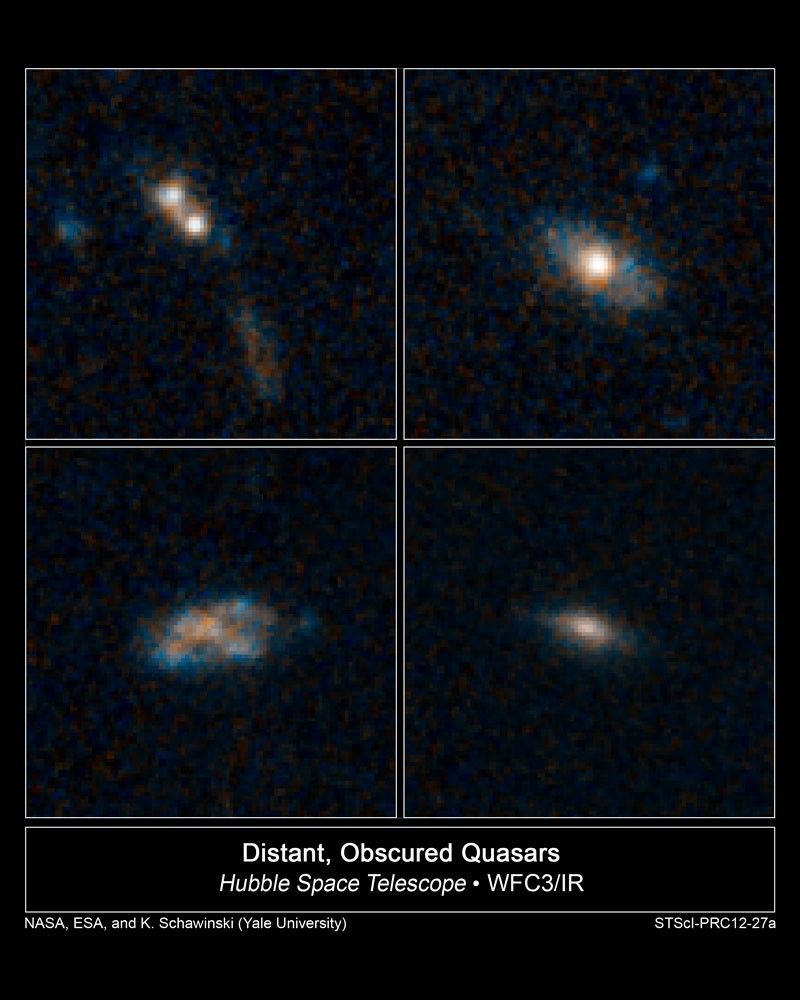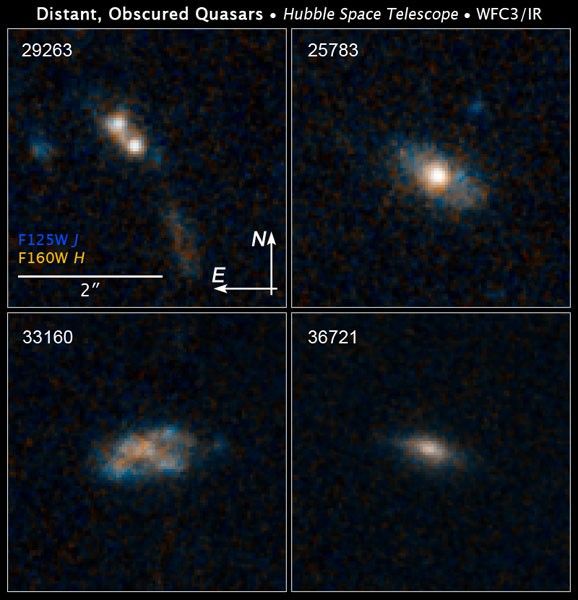1 min read
The Homes of Quasars

The galaxies in these four images have so much dust surrounding them that the brilliant light from their quasars cannot be seen in these Hubble Space Telescope images.
Quasars are the brilliant beacons of light that are powered by black holes feasting on captured material, and in the process, heating some of the matter to millions of degrees.
The galaxies are part of a census of 30 quasar host galaxies conducted with two of NASA's premier observatories, the Hubble Space Telescope and Spitzer Space Telescope. They were found in the Cosmic Assembly Near-infrared Deep Extragalactic Legacy Survey (CANDELS). The study shows that 26 of the host galaxies bear no tell-tale signs of collisions with neighbors, such as distorted shapes.
The quasars found in normal-looking galaxies are fainter than those powered by collisions between galaxies, which send lots of gas and dust into the gravitational whirlpool of hungry black holes. The dimmer quasars are triggered by black holes snacking on such tasty treats as a batch of gas or the occasional small satellite galaxy. They are the most abundant type of quasar, according to the Hubble analysis.
The images at top right, bottom left, and bottom right reveal three of the survey's normal-looking galaxies that host quasars. Only one galaxy in the sample, at top left, shows evidence of an interaction with another galaxy. The two white blobs are the cores from both galaxies. A streamer of material, colored brown and blue, also lies below the merging galaxies.
The galaxies existed roughly 8 billion to 12 billion years ago, during a peak epoch of black-hole growth. The galaxies' masses are comparable to our Milky Way's. The blue patches are star-forming regions. The brown areas are either dust or old stars.
The images were taken by Hubble's Wide Field Camera 3 between 2011 and 2012.
About the Data
- Data DescriptionData DescriptionProposal: A description of the observations, their scientific justification, and the links to the data available in the science archive.
Science Team: The astronomers who planned the observations and analyzed the data. "PI" refers to the Principal Investigator. - InstrumentInstrumentThe science instrument used to produce the data.HST>WFC3/IR
- Exposure DatesExposure DatesThe date(s) that the telescope made its observations and the total exposure time.June 19, 2012
- FiltersFiltersThe camera filters that were used in the science observations.F125W (J) and F160W (H)
- Object NameObject NameA name or catalog number that astronomers use to identify an astronomical object.Top row (left to right): Galaxy 29263 and Galaxy 25783 Bottom row (left to right): Galaxy 33160 and Galaxy 36721
- Object DescriptionObject DescriptionThe type of astronomical object.Extended Chandra Deep Field South galaxies from the CANDELS Survey
- Release DateJune 19, 2012
- Science ReleaseMost Quasars Live on Snacks, Not Large Meals
- Credit

This image is a composite of separate exposures acquired by the WFC3 IR instrument. Several filters were used to sample various wavelength ranges. The color results from assigning different hues (colors) to each monochromatic (grayscale) image associated with an individual filter. In this case, the assigned colors are: Blue: F125W (J) Orange: F160W (H)

Share
Details
Claire Andreoli
NASA’s Goddard Space Flight Center
Greenbelt, Maryland
claire.andreoli@nasa.gov

































